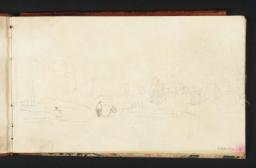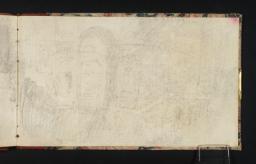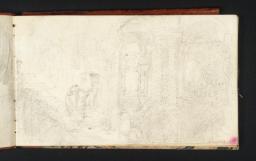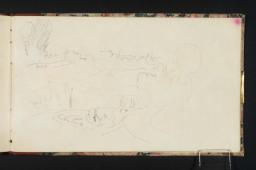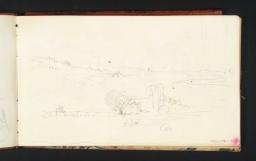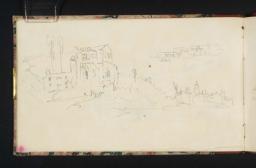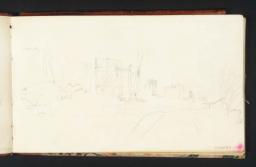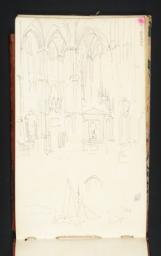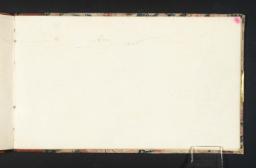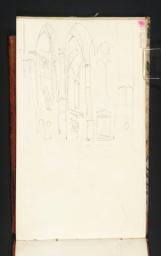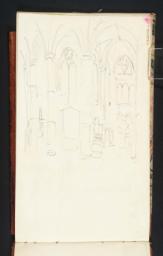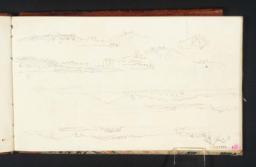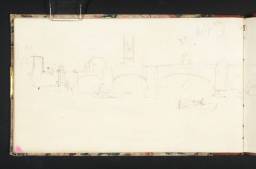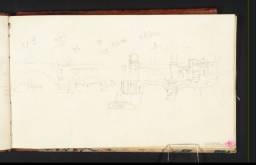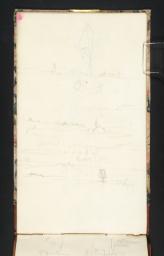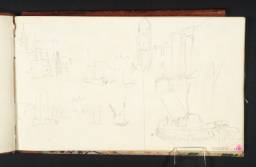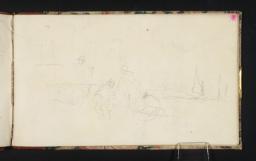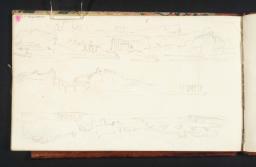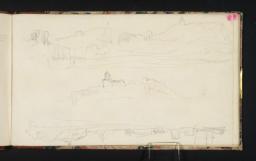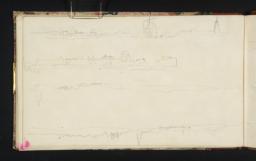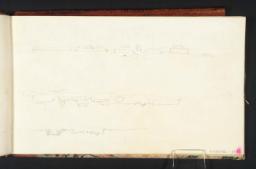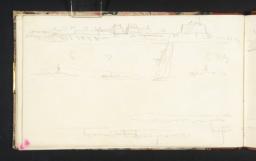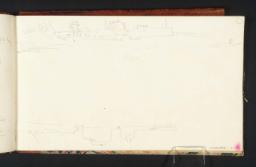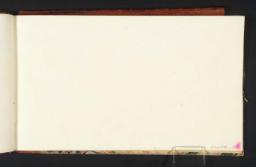Turner Bequest CCLXXVIII 1–40a
Sketchbook bound in boards, quarter bound in grey and faded red marbled paper with tan leather spine, pencil loop, and brass clasp
40 leaves of white laid paper
Numbered 325 as part of the Turner Schedule in 1854 and endorsed by the Executors of the Turner Bequest in ink and pencil on inside front cover (see entry for D41084)
40 leaves of white laid paper
Numbered 325 as part of the Turner Schedule in 1854 and endorsed by the Executors of the Turner Bequest in ink and pencil on inside front cover (see entry for D41084)
Accepted by the nation as part of the Turner Bequest 1856
References
This slim sketchbook was first dated to around 1832 by A.J. Finberg in his 1909 inventory of the Turner Bequest.1 A good deal of the volume has been left blank (especially the later folios) however those pages which have been worked up cover an eclectic range of subjects. Some of the initial pages of the sketchbook contain drawings of imaginary classical cityscapes and grand interiors. By contrast, the largest group of sketches depicts English waterside terrain including shipping and riverbanks. These are interspersed with architectural studies and cityscapes taken around London. The drawings are achieved in pencil, most of which are made up of rather cursory lines such as folio 10 verso (D27245; Turner Bequest CCLXXVIII 10a). However Turner also occasionally used broader tonal techniques in this sketchbook to create a sense of space and volume on folios like folio 2 recto (D27228; Turner Bequest CCLXXVIII 2).
The studies of classical architecture at the beginning of the sketchbook comprise a grand harbour view with figures on the inside front cover (D41084) and two Piranesi-like studies of vast vaulted interiors on folios 1 verso (D27227; Turner Bequest CCLXXVIII 1a) and 2 recto (D27228; Turner Bequest CCLXXVIII 2). Turner may have had one of the large classical oil compositions of the 1830s in mind when he made these studies, such as The Parting of Hero and Leander exhibited in 1837 (National Gallery, London)2 or Ancient Italy – Ovid banished from Rome exhibited in the following year (private collection).3 Curiously, Finberg tentatively connected the two interior scenes to The Parting of Hero and Leander although it is the work on the inside from cover which more closely resembles that painting.4
A small number of pages contain sketches taken at various points around London. A cluster of these drawings depict the river Thames around London Bridge and the nearby stretch of river known as the Pool of London; see folios 8 verso (D27241; Turner Bequest CCLXXVIII 8a), 9 recto (D27242; Turner Bequest CCLXXVIII 9), 10 recto (D27244; Turner Bequest CCLXXVIII 10). This area had long been a subject of Turner’s studies, with depictions in the Turner Bequest stretching back to the 1790s; see, for example, D00892 (Turner Bequest XXXIII U). More recently, in 1827, a print after one of Turner’s views of this part of the riverbank had been published; see Tate impression T06070. The other series of London sketches in this sketchbook were taken in Westminster Abbey; see folios 5 recto (D27234; Turner Bequest CCLXXVIII 5), 6 recto (D27236; Turner Bequest CCLXXVIII 6), 7 recto (D27238; Turner Bequest CCLXXVIII 7). These focus on the interior of the edifice, capturing the effect of its fine gothic vaulting and recording details of the monument to the English poet John Dryden; see especially folio 7 verso (D27239; Turner Bequest CCLXXVIII 7a). These were presumably made in preparation for an illustration for a new edition (1834–6) of Walter Scott’s Prose Works; see Tate impression T04727.
A small number of pages contain sketches taken at various points around London. A cluster of these drawings depict the river Thames around London Bridge and the nearby stretch of river known as the Pool of London; see folios 8 verso (D27241; Turner Bequest CCLXXVIII 8a), 9 recto (D27242; Turner Bequest CCLXXVIII 9), 10 recto (D27244; Turner Bequest CCLXXVIII 10). This area had long been a subject of Turner’s studies, with depictions in the Turner Bequest stretching back to the 1790s; see, for example, D00892 (Turner Bequest XXXIII U). More recently, in 1827, a print after one of Turner’s views of this part of the riverbank had been published; see Tate impression T06070. The other series of London sketches in this sketchbook were taken in Westminster Abbey; see folios 5 recto (D27234; Turner Bequest CCLXXVIII 5), 6 recto (D27236; Turner Bequest CCLXXVIII 6), 7 recto (D27238; Turner Bequest CCLXXVIII 7). These focus on the interior of the edifice, capturing the effect of its fine gothic vaulting and recording details of the monument to the English poet John Dryden; see especially folio 7 verso (D27239; Turner Bequest CCLXXVIII 7a). These were presumably made in preparation for an illustration for a new edition (1834–6) of Walter Scott’s Prose Works; see Tate impression T04727.
Most of the sketches in this volume depict riverside scenery and coastal terrain, often with shipping and figures. Finberg connected these drawings to works in the Life Class (1) sketchbook of about1835–40 (Turner Bequest CCLXXIX (a)), suggesting that, together, they incorporated much of the landscape around the mouth of the Thames in Essex and Kent, hence the title of the present volume.5 At that stage locations close to Purfleet, Whitstable, Gravesend, Chatham and Rochester, Margate, Broadstairs, and Ramsgate were proposed. This terrain is now much altered from Turner’s or even Finberg’s time, however Turner left notes on several leaves to confirm this general location. The name of Purfleet is found on folio 12 recto (D27248; Turner Bequest CCLXXVIII 12) and possibly folio 25 recto (D27264; Turner Bequest CCLXXVIII 25), Leigh-on-Sea is recorded on folio 16 verso (D27255; Turner Bequest CCLXXVIII 16a), and the name of Whitstable may be recorded, semi-legibly, on folio 14 recto (D27252; Turner Bequest CCLXXVIII 14). The full listing of drawings of shipping and waterside terrain in this sketchbook is as follows:
Folio 1 recto (D27226; Turner Bequest CCLXXVIII 1); folio 2 verso (D27229; Turner Bequest CCLXXVIII 2a); folio 3 recto (D27230; Turner Bequest CCLXXVIII 3); folio 4 recto (D27232; Turner Bequest CCLXXVIII 4); folio 4 verso (D27233; Turner Bequest CCLXXVIII 4a); folio 5 verso (D27235; Turner Bequest CCLXXVIII 5a); folio 6 verso (D27237; Turner Bequest CCLXXVIII 6a); folio 8 recto (D27240; Turner Bequest CCLXXVIII 8); folio 9 verso (D27243; Turner Bequest CCLXXVIII 9a); folio 10 verso (D27245; Turner Bequest CCLXXVIII 10a); folio 11 recto (D27246; Turner Bequest CCLXXVIII 11); folio 11 verso (D27247; Turner Bequest CCLXXVIII 11a); folio 12 verso (D27249; Turner Bequest CCLXXVIII 12a); folio 13 recto (D27250; Turner Bequest CCLXXVIII 13); folio 13 verso (D27251; Turner Bequest CCLXXVIII 13a); folio 14 recto (D27252; Turner Bequest CCLXXVIII 14); folio 16 verso (D27255; Turner Bequest CCLXXVIII 16a); folio 17 recto (D27256; Turner Bequest CCLXXVIII 17); folio 25 recto ( D27264; Turner Bequest CCLXXVIII 25).
A.J. Finberg, A Complete Inventory of the Drawings of the Turner Bequest, London 1909, vol.II, p.884
Martin Butlin and Evelyn Joll, The Paintings of J.M.W Turner, revised ed., New Haven and London 1984, pp.221–2 no.370, pl.374.
Alexander J. Finberg, The Life of J.M.W Turner, R.A. Second Edition, Revised, with a Supplement, by Hilda F. Finberg, revised ed. Oxford 1961, p.338. Finberg did not name these sketchbooks in these texts and they were only identified much later in Andrew Wilton, Turner in his Time, revised ed., London 2006, p.239.
Technical notes
How to cite
John Chu, ‘Mouth of the Thames sketchbook c.1832’, sketchbook, March 2015, in David Blayney Brown (ed.), J.M.W. Turner: Sketchbooks, Drawings and Watercolours, Tate Research Publication, August 2016, https://www


